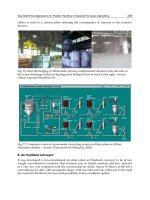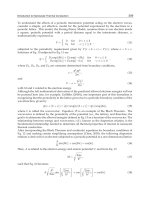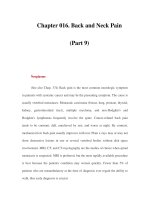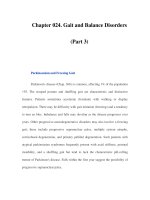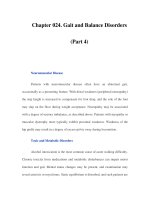Chapter 130. Streptococcal and Enterococcal Infections (Part 9) pptx
Bạn đang xem bản rút gọn của tài liệu. Xem và tải ngay bản đầy đủ của tài liệu tại đây (51.33 KB, 5 trang )
Chapter 130. Streptococcal and
Enterococcal Infections
(Part 9)
Streptococcal Toxic Shock Syndrome: Treatment
In light of the possible role of pyrogenic exotoxins or other streptococcal
toxins in streptococcal TSS, treatment with clindamycin has been advocated by
some authorities (Table 130-3), who argue that, through its direct action on protein
synthesis, clindamycin is more effective in rapidly terminating toxin production
than penicillin—a cell-wall agent. Support for this view comes from studies of an
experimental model of streptococcal myositis, in which mice given clindamycin
had a higher rate of survival than those given penicillin. Comparable data on the
treatment of human infections are not available. Although clindamycin resistance
in GAS is uncommon (<2% among U.S. isolates), it has been documented. Thus,
if clindamycin is used for initial treatment of a critically ill patient, penicillin
should be given as well until the antibiotic susceptibility of the streptococcal
isolate is known.
Intravenous immunoglobulin has been used as adjunctive therapy for
streptococcal TSS (Table 130-3). Pooled immunoglobulin preparations contain
antibodies capable of neutralizing the effects of streptococcal toxins. Anecdotal
reports and case series have suggested favorable clinical responses to intravenous
immunoglobulin, but no prospective controlled trials have been reported.
Prevention
No vaccine against GAS is commercially available. A formulation that
consists of recombinant peptides containing epitopes of 26 M-protein types has
undergone phase I and II testing in volunteers. Early results indicate that the
vaccine is well tolerated and elicits type-specific antibody responses.
Household contacts of individuals with invasive GAS infection (e.g.,
bacteremia, necrotizing fasciitis, or streptococcal TSS) are at greater risk of
invasive infection than the general population. Asymptomatic pharyngeal
colonization with GAS has been detected in up to 25% of persons with >4 h/d of
same-room exposure to an index case. However, antibiotic prophylaxis is not
routinely recommended for contacts of patients with invasive disease since such
an approach (if effective) would require treatment of hundreds of contacts to
prevent a single case.
Streptococci of Groups C and G
Group C and group G streptococci are β-hemolytic bacteria that
occasionally cause human infections similar to those caused by GAS. Strains that
form small colonies on blood agar (<0.5 mm) are generally members of the S.
milleri (S. intermedius, S. anginosus) group (see "Viridans Streptococci," below).
Large-colony group C and G streptococci of human origin are now considered a
single species, S. dysgalactiae subsp. equisimilis. They have been associated with
pharyngitis, cellulitis and soft-tissue infections, pneumonia, bacteremia,
endocarditis, and septic arthritis. Puerperal sepsis, meningitis, epidural abscess,
intraabdominal abscess, urinary tract infection, and neonatal sepsis have also been
reported. Group C or G streptococcal bacteremia most often affects elderly or
chronically ill patients and, in the absence of obvious local infection, is likely to
reflect endocarditis. Septic arthritis, sometimes involving multiple joints, may
complicate endocarditis or develop in its absence. Distinct streptococcal species of
Lancefield group C cause infections in domesticated animals, especially horses
and cattle; some human infections are acquired through contact with animals or
consumption of unpasteurized milk. These zoonotic organisms include S. equi
subsp. zooepidemicus and S. equi subsp. equi.
Group C or G Streptococcal Infection: Treatment
Penicillin is the drug of choice for treatment of group C or G streptococcal
infections. Antibiotic treatment is the same as for similar syndromes due to GAS
(Table 130-3). Patients with bacteremia or septic arthritis should receive
intravenous penicillin (2–4 mU every 4 h). All group C and G streptococci are
sensitive to penicillin; nearly all are inhibited in vitro by concentrations of ≤0.03
µg/mL. Occasional isolates exhibit tolerance: although inhibited by low
concentrations of penicillin, they are killed only by significantly higher
concentrations. The clinical significance of tolerance is unknown. Because of the
poor clinical response of some patients to penicillin alone, the addition of
gentamicin (1 mg/kg every 8 h for patients with normal renal function) is
recommended by some authorities for treatment of endocarditis or septic arthritis
due to group C or G streptococci; however, combination therapy has not been
shown to be superior to penicillin treatment alone. Patients with joint infections
often require repeated aspiration or open drainage and debridement for cure; the
response to treatment may be slow, particularly in debilitated patients and those
with involvement of multiple joints. Infection of prosthetic joints almost always
requires prosthesis removal in addition to antibiotic therapy.
Group B Streptococci
Identified first as a cause of mastitis in cows, streptococci belonging to
Lancefield's group B have since been recognized as a major cause of sepsis and
meningitis in human neonates. GBS is also a frequent cause of peripartum fever in
women and an occasional cause of serious infection in nonpregnant adults. Since
the widespread institution of prenatal screening for GBS in the 1990s, the
incidence of neonatal infection per 1000 live births has fallen from ~2–3 cases to
~1 case. During the same period, GBS infection in adults with underlying chronic
illnesses has become more common; adults now account for a larger proportion of
invasive GBS infections than do newborns. Lancefield group B consists of a single
species, S. agalactiae, which is definitively identified with specific antiserum to
the group B cell wall–associated carbohydrate antigen. A streptococcal isolate can
be classified presumptively as GBS on the basis of biochemical tests, including
hydrolysis of sodium hippurate (in which 99% of isolates are positive), hydrolysis
of bile esculin agar (in which 99–100% are negative), bacitracin susceptibility (in
which 92% are resistant), and production of CAMP factor (in which 98–100% are
positive). CAMP factor is a phospholipase produced by GBS that causes
synergistic hemolysis with βlysin produced by certain strains of S. aureus. Its
presence can be demonstrated by cross-streaking of the test isolate and an
appropriate staphylococcal strain on a blood agar plate. GBS organisms causing
human infections are encapsulated by one of nine antigenically distinct
polysaccharides. The capsular polysaccharide is an important virulence factor.
Antibodies to the capsular polysaccharide afford protection against GBS of the
same (but not of a different) capsular type.

